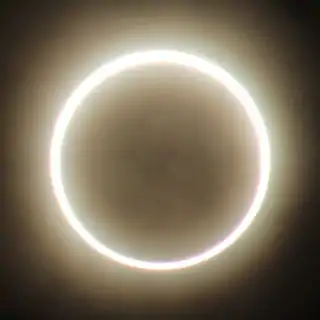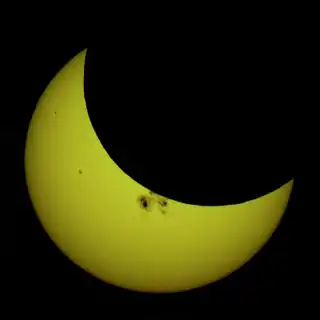| Solar eclipse of November 19, 1816 | |
|---|---|
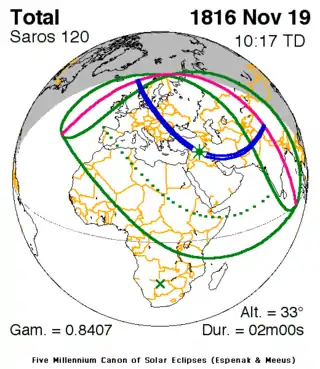 Map | |
| Type of eclipse | |
| Nature | Total |
| Gamma | 0.8408 |
| Magnitude | 1.0233 |
| Maximum eclipse | |
| Duration | 120 sec (2 m 0 s) |
| Coordinates | 35°00′N 41°30′E / 35°N 41.5°E |
| Max. width of band | 144 km (89 mi) |
| Times (UTC) | |
| Greatest eclipse | 10:17:23 |
| References | |
| Saros | 120 (50 of 71) |
| Catalog # (SE5000) | 9081 |
A total solar eclipse occurred on November 19, 1816. A solar eclipse occurs when the Moon passes between Earth and the Sun, thereby totally or partly obscuring the image of the Sun for a viewer on Earth. A total solar eclipse occurs when the Moon's apparent diameter is larger than the Sun's, blocking all direct sunlight, turning day into darkness. Totality occurs in a narrow path across Earth's surface, with the partial solar eclipse visible over a surrounding region thousands of kilometres wide.
Observations
From Germany, this total eclipse could not be seen with clouded sky except by few observers at Pomerania only.[1]
Capel Lofft observed this eclipse from Ipswich.[2]
Related eclipses
It is a part of solar Saros 120.
Tritos series
This eclipse is a part of a tritos cycle, repeating at alternating nodes every 135 synodic months (≈ 3986.63 days, or 11 years minus 1 month). Their appearance and longitude are irregular due to a lack of synchronization with the anomalistic month (period of perigee), but groupings of 3 tritos cycles (≈ 33 years minus 3 months) come close (≈ 434.044 anomalistic months), so eclipses are similar in these groupings.
| Series members between 1801 and 2100 | |||
|---|---|---|---|
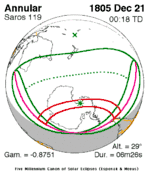 December 21, 1805 (Saros 119) |
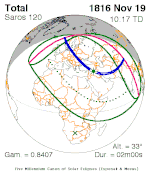 November 19, 1816 (Saros 120) |
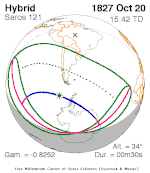 October 20, 1827 (Saros 121) | |
 September 18, 1838 (Saros 122) |
 August 18, 1849 (Saros 123) |
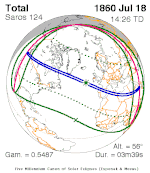 July 18, 1860 (Saros 124) | |
 June 18, 1871 (Saros 125) |
 May 17, 1882 (Saros 126) |
 April 16, 1893 (Saros 127) | |
 March 17, 1904 (Saros 128) |
 February 14, 1915 (Saros 129) |
 January 14, 1926 (Saros 130) | |
 December 13, 1936 (Saros 131) |
 November 12, 1947 (Saros 132) |
 October 12, 1958 (Saros 133) | |
 September 11, 1969 (Saros 134) |
 August 10, 1980 (Saros 135) |
 July 11, 1991 (Saros 136) | |
 June 10, 2002 (Saros 137) |
 May 10, 2013 (Saros 138) |
 April 8, 2024 (Saros 139) | |
 March 9, 2035 (Saros 140) |
 February 5, 2046 (Saros 141) |
 January 5, 2057 (Saros 142) | |
 December 6, 2067 (Saros 143) |
 November 4, 2078 (Saros 144) |
 October 4, 2089 (Saros 145) | |
 September 4, 2100 (Saros 146) |
|||
In the 22nd century:
- Solar saros 147: annular solar eclipse of August 4, 2111
- Solar saros 148: total solar eclipse of July 4, 2122
- Solar saros 149: total solar eclipse of June 3, 2133
- Solar saros 150: annular solar eclipse of May 3, 2144
- Solar saros 151: annular solar eclipse of April 2, 2155
- Solar saros 152: total solar eclipse of March 2, 2166
- Solar saros 153: annular solar eclipse of January 29, 2177
- Solar saros 154: annular solar eclipse of December 29, 2187
- Solar saros 155: total solar eclipse of November 28, 2198
In the 23rd century:
- Solar saros 156: annular solar eclipse of October 29, 2209
- Solar saros 157: annular solar eclipse of September 27, 2220
- Solar saros 158: total solar eclipse of August 28, 2231
- Solar saros 159: partial solar eclipse of July 28, 2242
- Solar saros 160: partial solar eclipse of June 26, 2253
- Solar saros 161: partial solar eclipse of May 26, 2264
- Solar saros 162: partial solar eclipse of April 26, 2275
- Solar saros 163: partial solar eclipse of March 25, 2286
- Solar saros 164: partial solar eclipse of February 22, 2297
Notes
- ↑ ON THE ECLIPSES AND OCCULTATIONS SEEN IN GERMANY IN THE PAST
- ↑ Blake, William (1796). "The Monthly magazine. v.42 (1816). - Full View | HathiTrust Digital Library | HathiTrust Digital Library". Monthly Magazine and Critical Register of Books. Retrieved 2017-07-04.
References
- NASA chart graphics
- Googlemap
- NASA Besselian elements
- The 1816 Solar Eclipse and the Comet 1811I in Linnell's Astronomical Album JOURN. HISTORY OF ASTRONOMY V.23, NO. 2/MAY, P.121, 1992
.jpg.webp)
